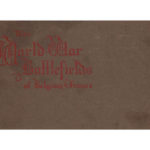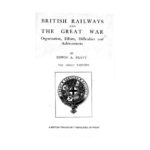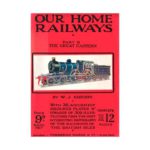Description
A similar publication, by the East Coast Companies, produced for the Americantmarket is at:
http://www.
Long before the Trades Description Act, there were few legal tricks which a Railway Company would not stoop to in attempting to siphon off a share of some lucrative traffic from a rival.. Until the big transatlantic steamships abandoned Liverpool for Southampton (White Star,1907, Cunard 1919) the London & North Western Railway regarded this business as its own particular preserve, providing a floating landing stage served directly by luxuriously appointed trains from London. It jealously guarded the residual North Amrican trade afterwards, almost as if the USA was an extension of its own territory. This attitude continued under the LMS, when among the few extravagances permitted by that arch “Bean Counter”, Sir Josiah Stamp, locomotives and carriages were sent at considerable expence to Exhibitions in the USA, the “Royal Scot” in 1933 (not the original but a new loco taking the name permanently), and “Coronation”, (although actually “Duchess of Hamilton” with borrowed nameplates) in 1938.
Other companies nibbled at the LNWR pie. The GWR reached the Mersey via Birkenhead, ferrying transatlantic passengers across the river, while the Midland, ran trains into Liverpool Central. It could not run trains onto the landing stage, stage, but compensated by building a large luxurious hotel, “The Adelphi” whose warm comforts were much appreciated by passengers sea-sick or frozen by a winter crossing, compared to the austere and chilly Gothic styled LNWR establishment at Lime Street Station.
A surprising contender for passengers travelling through to the continent, was the Great Eastern Railway, which offered a through carriage at 2-30pm. from Central Station to the side of the steamer at Parkeston Quay, conveying passengers and their luggage without changing, via Lincoln and the GN &GE joint line. One assumes that this vehicle would be attached to the daily York – Harwich Boat Express train en route. Other through carriages are offered, Midland Railway, 12-50pm from Central, the L&Y at 2-10pm from Exchange, while passengers can leave Lime Street, LNWR, at 2-00pm. (“changing at Rugby Junction into a Through Corridor Carriage to Parkeston Quay”. All these in connection with the night steamer services.
The brochure is silent on the subject of refreshments on all these services, save the Boat Expresses, which have dining cars, so recourse would have to be made to the Luncheon and Tea Baskets booked in advance from refreshment rooms. It is no doubt with a sigh of relief that passengers in the 2-30pm. through carriage from Liverpool Central found themselves attached to the York -Harwich Boat Express with access to a Dining Car. As these through carriages were probably single luggage composites (much luggage space would be required for the voluminous cabin trunks essential to a transatlantic crossing) seating probably no more than 25 passengers, one wonders if it was a financially viable,, as each Railway over which the carriage ran would get a proportion of the fare credited to it by the Railway Clearing House.
The through carriage to the side of the steamer could be a blessing, enabling a passenger with much luggage to avoid crossing London hampered by trunks to Liverpool Street for the boat express, even if the journey on the Joint Line, with its endless vistas of black fields or floods, dykes and ditches did give a whole new concept of the meaning of eternity…Also, in 1906, it is unlikely that there was any steam heating in the through carriage at least until attachment to the York train. However, the fare via the cross country route would be cheaper. Personally, I would have wired ahead for a conveyance for self and trunks from Euston to Liverpool Street. The cross country journey from Rugby to Harwich would have been almost as tedious as via the Joint Line. Any passenger travelling from Liverpool to London only who was booked by the Cathedral Route because of the the blandishments of this brochure should have sued the travel Agent.
The smooth riding LNWR 12-wheeled Dining Car and a five course luncheon would have filled the journey to Euston most agreeably. A wash and Brush-up at the Great Eastern Hotel at Liverpool Street, and registering the luggage through to my continental destination would comfortably occupy the time until the departure of the Harwich Boat Train and an excellent a la carte dinner on board.
The map is a real curiosity of dis-information. Cambridge is placed almost in the Midlands, some distance west of Peterborough. The GN&GE Joint line and connections, is an almost straight line running from Ely to York, via Lincoln – again shown west of Peterborough – while the Great Northern East Coast main line, is depicted as a very thin black line, which peters out somewhere north of Newark. The GWR, LNWR and Midland main lines to the north are treated in a similar cavalier fashion, while the GCR south of Sheffield has largely disappeared. It must have puzzled any American travellers with an elementary knowledge of English Geography . The brochure is packed with information on fares to various destinations.
PREVIEW BELOW – MAY TAKE A WHILE TO LOAD.




Reviews
There are no reviews yet.